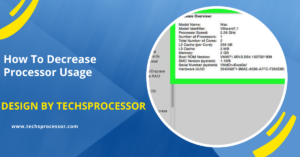Is An Environment Where Processors Are Embedded In Objects – A Comprehensive Overview!
The Internet of Things (IoT) is a network of everyday objects embedded with processors and sensors, enabling data collection, exchange, and analysis to enhance functionality and connectivity across various sectors.
Introduction:
In today’s digital age, processors are not confined to traditional computers and smartphones. They are embedded in everyday objects, creating a connected environment often referred to as the Internet of Things (IoT). This integration of processors into various objects enhances functionality and enables smarter interactions with the world around us.
What is the Internet of Things (IoT)?

The Internet of Things (IoT) refers to a network of physical objects embedded with sensors, software, and other technologies, allowing them to connect and exchange data with other devices and systems over the internet.
These objects, equipped with processors, can range from household appliances and wearable devices to industrial machines and smart city infrastructure.
How IoT Works:
IoT devices collect data from their environment using embedded sensors and processors. This data is then transmitted over a network, typically the internet, to be processed and analyzed.
The processed data can trigger actions or provide insights, creating a feedback loop that continuously enhances the device’s functionality and user experience.
Key Components of IoT Systems:
- Sensors and Actuators: Sensors collect data from the environment, while actuators perform actions based on processed data.
- Connectivity: IoT devices use various connectivity options such as Wi-Fi, Bluetooth, cellular, and more to communicate.
- Data Processing: Embedded processors handle initial data processing before sending it to more powerful servers or cloud-based systems for further analysis.
- User Interface: Users interact with IoT devices through interfaces such as mobile apps, web dashboards, or voice commands.
Also Read: How To Tell If Processor Is Dead – Exploring The Signs, Symptoms, and Diagnostic Steps!
Benefits of Embedded Processors in IoT:
Embedded processors in IoT devices offer numerous benefits, including improved efficiency and automation, enhanced connectivity, comprehensive data collection and analysis, and increased convenience and control.
These processors enable objects to make autonomous decisions, share information seamlessly, gather and analyze data for valuable insights, and provide users with the ability to monitor and control devices remotely.
Applications of Embedded Processors in IoT:
- Smart Homes: Home automation systems use embedded processors to control lighting, heating, security, and entertainment systems, making homes more energy-efficient and comfortable.
- Healthcare: Wearable devices and medical equipment with embedded processors monitor vital signs, track health metrics, and assist in remote patient care.
- Industrial Automation: Embedded processors in industrial machines and equipment improve manufacturing processes, reduce downtime, and enhance safety.
- Smart Cities: IoT-enabled infrastructure, such as smart streetlights and traffic management systems, helps improve urban living conditions and reduce energy consumption.
- Agriculture: IoT devices in agriculture monitor soil conditions, weather patterns, and crop health, enabling precision farming and better resource management.
- Transportation: IoT in transportation includes smart traffic management, fleet tracking, and autonomous vehicles, enhancing safety and efficiency.
Challenges and Considerations:

While IoT offers numerous advantages, it also presents challenges such as ensuring security and privacy, achieving interoperability among diverse devices, managing power efficiently, scaling infrastructure, handling massive data volumes, and minimizing latency for real-time applications. Addressing these challenges is crucial for the successful deployment and operation of IoT systems.
Future of IoT and Embedded Processors:
The future of IoT and embedded processors looks promising with advancements in edge computing, 5G connectivity, AI integration, and sustainability efforts. Edge computing brings data processing closer to the source, reducing latency and bandwidth usage.
The rollout of 5G networks provides faster and more reliable connectivity. AI integration enables smarter decision-making and predictive analytics. Additionally, IoT technologies contribute to sustainability by optimizing energy use and reducing waste.
FAQ’s
1. What is the Internet of Things (IoT)?
The IoT is a network of physical objects embedded with sensors and processors, enabling them to connect and exchange data over the internet.
2. How do IoT devices work?
IoT devices collect data using embedded sensors and processors, transmit it over a network, process it, and use the insights to perform actions or improve functionality.
3. What are some examples of IoT applications?
Examples include smart homes, wearable health devices, industrial automation, smart city infrastructure, precision agriculture, and transportation systems.
4. What benefits do embedded processors bring to IoT devices?
Embedded processors improve efficiency, enable automation, enhance connectivity, allow comprehensive data collection and analysis, and increase user convenience and control.
5. What are the key components of an IoT system?
The key components are sensors and actuators, connectivity options, data processing units, and user interfaces.
6. What challenges does IoT face?
Challenges include ensuring security and privacy, achieving device interoperability, managing power efficiently, scaling infrastructure, handling large data volumes, and minimizing latency.
7. How can IoT improve smart homes?
IoT in smart homes controls lighting, heating, security, and entertainment systems, making homes more energy-efficient and comfortable.
8. What role does IoT play in healthcare?
IoT in healthcare involves wearable devices and medical equipment that monitor vital signs, track health metrics, and assist in remote patient care.
9. What advancements are expected in the future of IoT?
Future advancements include edge computing, 5G connectivity, AI integration, and sustainability efforts to optimize energy use and reduce waste.
10. Why is addressing IoT challenges crucial?
Addressing these challenges is essential for the successful deployment, operation, and sustainable growth of IoT systems across various sectors.
Conclusion
The integration of processors into everyday objects through the Internet of Things is transforming the way we live and work. By enhancing connectivity, efficiency, and convenience, IoT creates smarter environments that can adapt to our needs and improve overall quality of life. However, addressing challenges such as security, interoperability, and power management is crucial for the sustainable growth of IoT technologies. As this field continues to evolve, it holds immense potential for innovation and progress across various sectors.





Post Comment